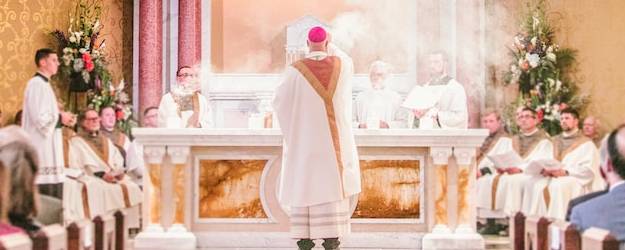Christ’s Action in the Liturgy
Question: The priest is said to act “in the person of Christ” during the Eucharist prayer. Is this true only at the words of institution or during the whole Mass?
Answer: As a ritual, the Mass is heaven on earth begun. It is making present in time and on earth the great eternal worship of the Lamb in heaven which is described in the book of Revelation.
The Catechism of the Catholic Church clearly teaches: “Liturgy is an ‘action’ of the whole Christ (Christus totus). Those who even now celebrate it without signs are already in the heavenly liturgy, where celebration is wholly communion and feast.” (CCC 1136) The action of the Mass has as its principal celebrant not the human priest but Christ Himself from heaven. The human priest is merely his minister. This is because this action is both his ongoing sacrifice made present to us and in transubstantiation involves a miracle.
Still, there are essential parts to this action: offertory, consecration and communion. So though it is fitting for the whole ritual to be an action “in the person of Christ the Head (in persona Christi capitis)” the direct action of Christ would only be necessary in the actual three parts of the sacrifice. It is here that the human priest no longer acts as the person whose name is on his passport, but as Christ Himself. The reason the human priest wears special vestments, uses ritual language, and celebrates in a sanctuary set apart from the rest of the church is to emphasize that this is the “making present” of the heavenly oblation which was begun in the one bloody sacrifice and continues to be applied in an unbloody way. This is also the reason that, should the human priest be interrupted, say, by death or an emergency once the offertory has begun, the ritual must be completed later by any human priest: because it is Christ who is the primary celebrant in an action which is already taking place continually in eternity. So because of the union of the ritual, the priest acts “in persona Christi capitis” for the whole Mass though this is only strictly necessary for the sacrificial part.
The Real Presence: Substance and Accident
Question: According to transubstantiation, the elements are bread and wine. These are substantially changed into the Body and Blood of Christ? Does this include the accidents of the bread and wine or do they remain?
Answer: The change in the Eucharist is, as you rightly say, called transubstantiation. As the Catechism puts it:
The mode of Christ’s presence under the Eucharistic species is unique. It raises the Eucharist above all the sacraments as “the perfection of the spiritual life and the end to which all the sacraments tend.” In the most blessed sacrament of the Eucharist “the body and blood, together with the soul and divinity, of our Lord Jesus Christ and, therefore, the whole Christ is truly, really, and substantially contained.” ‘This presence is called ‘real’ — by which is not intended to exclude the other types of presence as if they could not be ‘real’ too, but because it is presence in the fullest sense: that is to say, it is a substantial presence by which Christ, God and man, makes himself wholly and entirely present.” (CCC 1374)
What does substantial presence mean in this instance? This change is a miracle because in all other natural changes on earth, a change in substance is accompanied by a change in properties (accidents). But wisely and miraculously, in this change, only the accidents of the bread and wine are preserved on earth but are changed into the whole Christ now risen in heaven (body, Blood, soul, and divinity). The dimension and the quantity of the body (fingers, toes, etc.) exist in heaven and are present in the substance on earth, but the dimensive quantity is only present in the Eucharist because the substance is. This is what preserves us from cannibalism. Bread and wine remain in their accidents and properties and become the vehicle which is the same before and after the change. But the bread does not bleed when it is broken.
This change is a miracle because the properties of bread and wine remain. If one drinks enough of the precious blood one can become drunk. Yet the properties underlie the conversion of the whole substance, which is composed of both the matter and form of bread and wine, into the matter and form of Christ’s risen body. This takes place in such a way that if the properties are divided, as in breaking the bread into two pieces, one does not have two pieces of Christ as would be the case with the change in nature where the matter is the vehicle which is the substratum of the change. In this change, the matter changes but the properties are the substratum of the change of the whole being. A broken consecrated host is not two pieces of Christ, but the whole Christ, body, blood, soul, and divinity, under each part.
Also, because of the nature of this change, there are not 10 million bodies of Christ in tabernacles, but the one body of Christ in heaven with the eyes, hands, feet, etc. and divinity present equally in 10 million different places so that each of us receives the same Christ. So the answer to your question is that the matter and the form change, but the properties of accidents remain. “Godhead here in hiding, whom I do adore.” (Adoro te devote as translated by Gerard Manley Hopkins)

Recent Comments